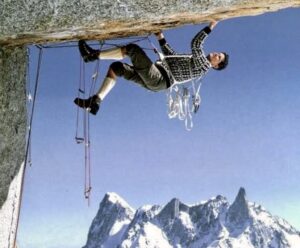Mont Blanc (or Monte Bianco in Italian, since the peak straddles the Italian and Swiss borders) is the highest and the most popular climb in Western Europe. It is also many climbers’ first flirtation with high-altitude mountaineering. Chamonix, near the foot of the mountain, is also the world’s most chichi and developed mountain town. Here, they build statues to guides rather than politicians. Many consider Mont Blanc the cradle of alpinism. No wonder anything unusual that happens on its slopes creates a stir.

Chamonix. Photo: Jerry Kobalenko
Last week, the unusual happened again on Mont Blanc, and the news went viral across Europe: A small plane managed to land on the peak’s upper slopes, at 4,550m between the Wall of the Coast and the upper Red Rocks, two well-known features for those who climb via the 4000’ers ridge route.
Two Swiss mountaineers in the plane, equipped with rope and crampons, sallied out to climb the last 300m of Mont Blanc, but were intercepted by a helicopter patrol and forced to return and fly their plane back off the mountain, under escort.
Local officials were outraged. “An unprecedented provocation… an intolerable attack,” fumed the mayor of Chamonix. The mayor of nearby Saint-Gervais declared himself “deeply irritated” and hurriedly passed new restrictions. Under these, climbers must have a confirmed reservation at one of the mountain huts, to ensure no unauthorized bivouacking or camping. Strictly speaking, these new regulations say nothing about quick aerial incursions.
Apparently, it was not easy to decide exactly which crime the two plane-hoppers had committed, and it seems that officials are still hunkered down trying to decide a suitable fine or punishment.
Probably the idea seemed too outlandish to consider legislating against, although mountaineering history abounds in comparably crazy plans. Overall, planes and mountain faces don’t fit well together, and fixed-wing approaches typically only occur on isolated ice caps in Antarctica, Alaska and northern Canada.
Still, landing/crashing a plane on a mountain flank is far from new. Back in 1932, Maurice Wilson decided to make the first ascent of Mount Everest, solo. He planned to crash a small plane on Everest’s upper slopes and scoot to the top from there. Through this improbable project, he hoped to demonstrate the power of fasting and prayer.

The eccentric Maurice Wilson and his Gipsy Moth aircraft. He christened it Ever Wrest, pun regrettably intended.
It didn’t help his cause that Wilson had no mountaineering experience and poor flying skills. After an early accident while still in England, the Air Ministry banned him from the skies. But the eccentric Wilson — in England, “eccentric” is a polite term for a nut with resources — managed to steal away and eventually flew himself all the way to India. From there, he trekked on foot to Everest and managed to reach 6,900m — or higher, according to some theories– before dying gloriously on its slopes. Compared to Wilson, the Mont Blanc kerfuffle does not seem that extraordinary, after all.
About Mont Blanc
Two hundred summits on a good summer day are not uncommon. There are also about 50 casualties and 1,200 rescues a year. Typically, the climb takes two days from Chamonix, with a rest before the summit day at either the Gouter, Tete Rouse or Cosmiques refuges. However, the places are so crowded in summer, with nearly all places booked by guiding companies, that a number of people spend (or used to, before the recent restrictions) the last evening camped either beside the refuges or along the route. There are also routes from Italy, longer and more technical, as well as some top-level climbs, including the Peuterey Integrale and the Freney Pillar routes.






